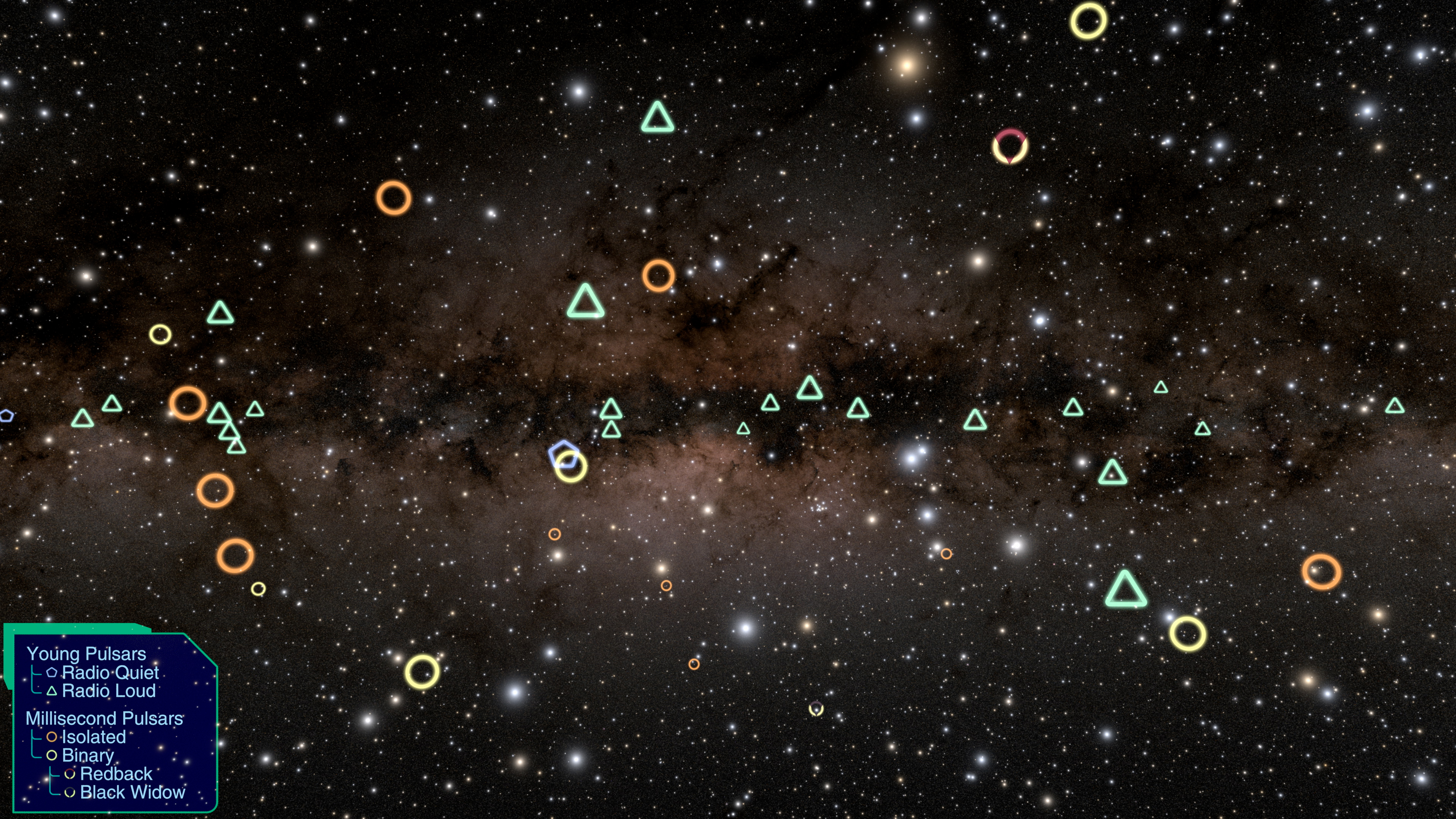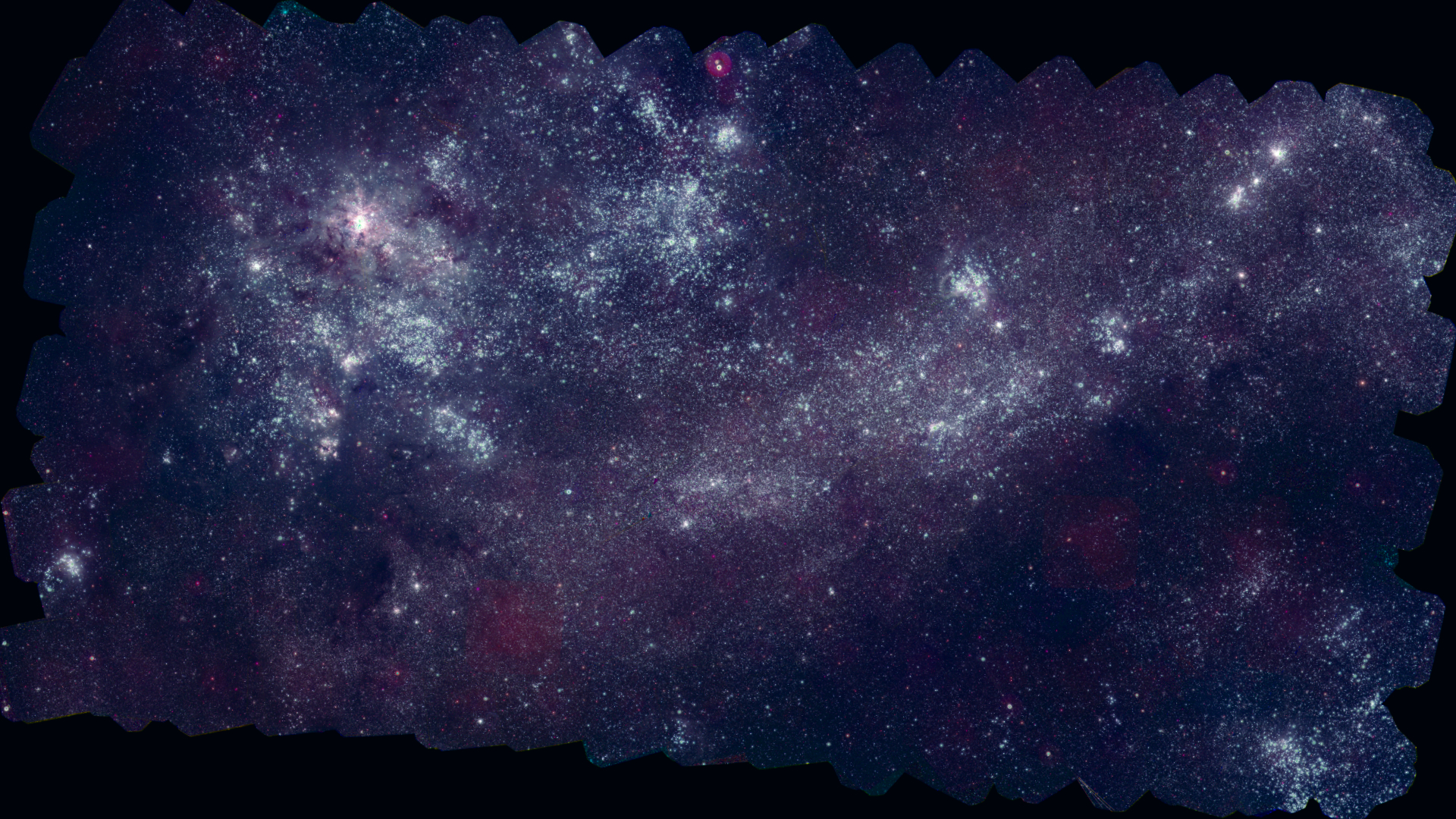Fermi finds the first extragalactic gamma-ray pulsar
Explore Fermi's discovery of the first gamma-ray pulsar detected in a galaxy other than our own.
Credit: NASA's Goddard Space Flight Center
Watch this video on the NASA Goddard YouTube channel.
For complete transcript, click here.
Researchers using NASA's Fermi Gamma-ray Space Telescope have discovered the first gamma-ray pulsar in a galaxy other than our own. The object sets a new record for the most luminous gamma-ray pulsar known.
The pulsar lies in the outskirts of the Tarantula Nebula in the Large Magellanic Cloud, a small galaxy that orbits our Milky Way and is located 163,000 light-years away. The Tarantula Nebula is the largest, most active and most complex star-formation region in our galactic neighborhood. It was identified as a bright source of gamma rays, the highest-energy form of light, early in the Fermi mission. Astronomers initially attributed this glow to collisions of subatomic particles accelerated in the shock waves produced by supernova .
However, the discovery of gamma-ray pulses from a previously known pulsar named PSR J0540-6919 shows that it is responsible for roughly half of the gamma-ray brightness previously thought to come from the nebula.
Gamma-ray pulses from J0540-6919 have 20 times the intensity of the previous record-holder, the pulsar in the famous Crab Nebula. Yet they have roughly similar levels of radio, optical and X-ray emission. Accounting for these differences will guide astronomers to a better understanding of the extreme physics at work in young pulsars.

NASA's Fermi Gamma-ray Space Telescope has detected the first extragalactic gamma-ray pulsar, PSR J0540-6919, near the Tarantula Nebula (top center) star-forming region in the Large Magellanic Cloud, a satellite galaxy that orbits our own Milky Way. Fermi detects a second pulsar (right) as well but not its pulses. PSR J0540-6919 now holds the record as the highest-luminosity gamma-ray pulsar. The angular distance between the pulsars corresponds to about half the apparent size of a full moon. Background: An image of the Tarantula Nebula and its surroundings in visible light.
Credit: NASA's Goddard Space Flight Center; background: ESO/R. Fosbury (ST-ECF)

Unlabeled version of above.

A gamma-ray view of the same region shown above in visible wavelengths. Lighter colors indicate greater numbers of gamma rays with energies between 2 and 200 billion electron volts. For comparison, visible light ranges between 2 and 3 electron volts. The two pulsars, PSR J0540−6919 (left) and PSR J0537−6910, clearly stand out.
Credit: NASA/DOE/Fermi LAT Collaboration

The Tarantula Nebula (top center) is the largest, most active and most complex stellar nursery in our galactic neighborhood. It lies in the Large Magellanic Cloud, a satellite galaxy that orbits our own Milky Way about 163,000 light-years away. This image shows the Tarantula Nebula and its surroundings in a visible light image spanning one degree. The view is a mosaic captured with the Wide Field Imager on the 2.2-m telescope at the European Southern Observatory, La Silla, Chile.
Credit: ESO/R. Fosbury (ST-ECF)

A gamma-ray view of the same region shown above in visible wavelengths. Lighter colors indicate greater numbers of gamma rays with energies between 2 and 200 billion electron volts. For comparison, visible light ranges between 2 and 3 electron volts. The two pulsars, PSR J0540−6919 (left) and PSR J0537−6910, clearly stand out.
Credit: NASA/DOE/Fermi LAT Collaboration

This image shows gamma-ray emission across a 10-degree-wide patch of the sky centered on the Large Magellanic Cloud. Lighter colors indicate greater numbers of gamma rays with energies between 0.2 and 200 billion electron volts (GeV). The brightest glow comes from the vicinity of the Tarantula Nebula star-forming region. Early in the Fermi mission, astronomers attributed this glow to collisions of subatomic particles accelerated in the shock waves produced by supernova explosions. However, much of it is now known to come from a single pulsar called PSR J0540-6919.
Credit: NASA/DOE/Fermi LAT Collaboration

This image shows gamma-ray emission across a 2-degree-wide patch of the sky centered on the Tarantula Nebula star-forming region in the Large Magellanic Cloud. Lighter colors indicate greater numbers of gamma rays with energies between 2 and 200 billion electron volts (GeV). Fermi's Large Area Telescope has better angular resolution at higher gamma-ray energies, allowing astronomers to resolve the broad glow of the Tarantula Nebula into two components coinciding with the pulsars PSR J0540−6919 and PSR J0537−6910.
Credit: NASA/DOE/Fermi LAT Collaboration
For More Information
Credits
Please give credit for this item to:
NASA's Goddard Space Flight Center. However, individual items should be credited as indicated above.
-
Narrator
- Scott Wiessinger (USRA)
-
Science writer
- Francis Reddy (Syneren Technologies)
-
Writer
- Scott Wiessinger (USRA)
-
Producer
- Scott Wiessinger (USRA)
-
Animator
- Scott Wiessinger (USRA)
Release date
This page was originally published on Thursday, November 12, 2015.
This page was last updated on Wednesday, May 3, 2023 at 1:49 PM EDT.
Missions
This visualization is related to the following missions:Series
This visualization can be found in the following series:Tapes
This visualization originally appeared on the following tapes:-
LMC Pulsar
(ID: 2015084)
Thursday, November 12, 2015 at 5:00AM
Produced by - Robert Crippen (NASA)


